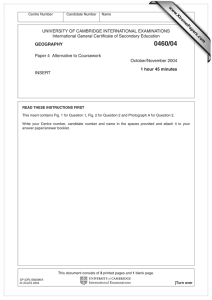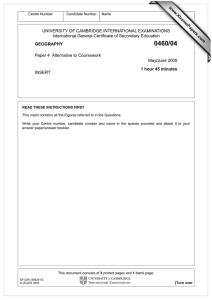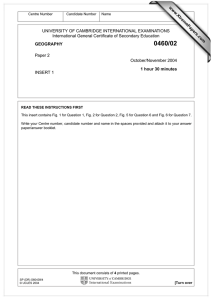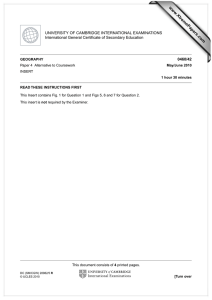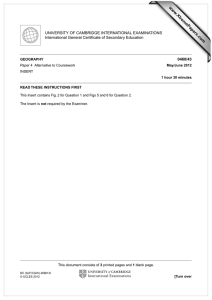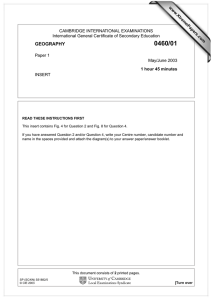www.XtremePapers.com
advertisement
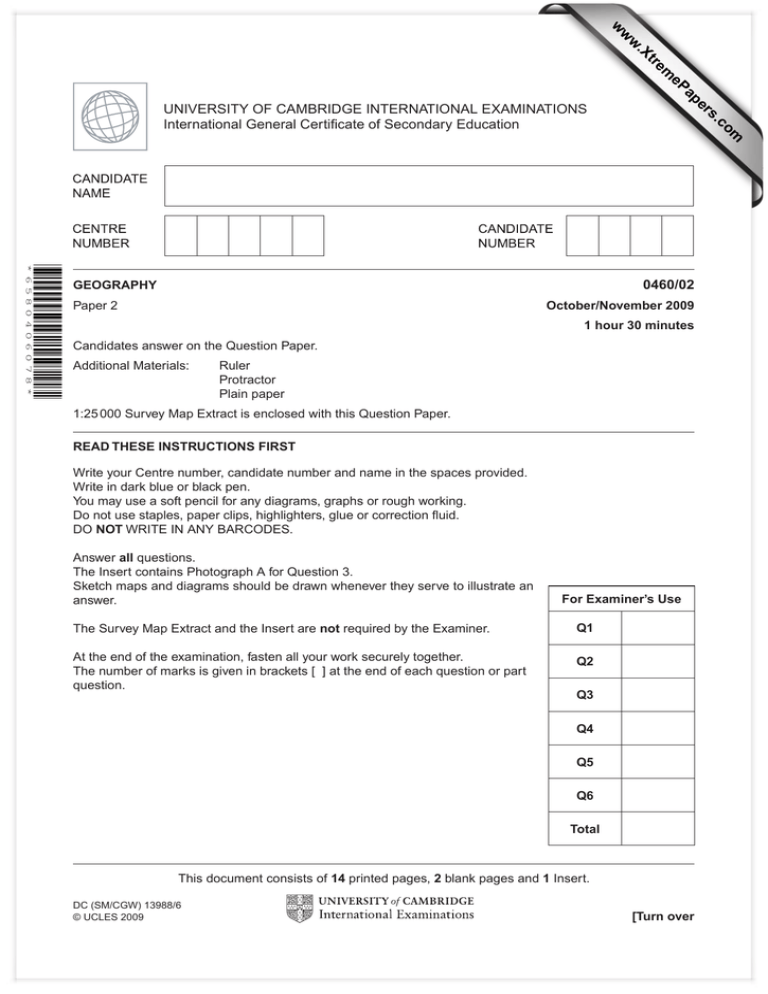
w w ap eP m e tr .X w om .c s er UNIVERSITY OF CAMBRIDGE INTERNATIONAL EXAMINATIONS International General Certificate of Secondary Education *6580406078* 0460/02 GEOGRAPHY Paper 2 October/November 2009 1 hour 30 minutes Candidates answer on the Question Paper. Additional Materials: Ruler Protractor Plain paper 1:25 000 Survey Map Extract is enclosed with this Question Paper. READ THESE INSTRUCTIONS FIRST Write your Centre number, candidate number and name in the spaces provided. Write in dark blue or black pen. You may use a soft pencil for any diagrams, graphs or rough working. Do not use staples, paper clips, highlighters, glue or correction fluid. DO NOT WRITE IN ANY BARCODES. Answer all questions. The Insert contains Photograph A for Question 3. Sketch maps and diagrams should be drawn whenever they serve to illustrate an answer. For Examiner’s Use The Survey Map Extract and the Insert are not required by the Examiner. Q1 At the end of the examination, fasten all your work securely together. The number of marks is given in brackets [ ] at the end of each question or part question. Q2 Q3 Q4 Q5 Q6 Total This document consists of 14 printed pages, 2 blank pages and 1 Insert. DC (SM/CGW) 13988/6 © UCLES 2009 [Turn over 2 1 The map extract is for the area around Vernon Hill, Mauritius. The scale is 1:25 000. (a) Fig. 1 shows the position of some features in the south west part of the map extract. Study the map extract and Fig. 1 and answer the questions on the opposite page. 06 80 07 08 09 80 E F 79 79 D A 78 78 B 77 77 C 76 06 76 07 08 Fig. 1 © UCLES 2009 0460/02/O/N/09 09 For Examiner’s Use 3 Using the map extract, identify the following features shown on Fig. 1: (i) For Examiner’s Use feature A (063785); ..............................................................................................................................[1] (ii) the named or public building at B (072778); ..............................................................................................................................[1] (iii) the features labelled C (0676); ..............................................................................................................................[1] (iv) feature D (086793); ..............................................................................................................................[1] (v) the name of river E (0879); ..............................................................................................................................[1] (vi) two types of land use/vegetation in area F (0679). 1 ............................................................................................................................... 2 ...........................................................................................................................[2] © UCLES 2009 0460/02/O/N/09 [Turn over 4 (b) Fig. 2 is a cross section drawn along northing 79 from 090790 to 120790. For Examiner’s Use River Terre Glaise 300 300 height 200 (metres) 200 100 100 090790 height (metres) 120790 Fig. 2 On Fig. 2, using labelled arrows, mark the positions of: (i) the Feeder Tibere River; (ii) the B83 road; (iii) the east facing slope of Vernon Hill. [3] (c) Look at the straight section of the B7 road from the junction with the main A road at New Grove (093763) to the start of the bend at 111775. (i) Measure the distance of this straight section of road. Give your answer in metres. ............................................................................................................... metres [1] (ii) Measure the bearing from grid north of this straight section of road from the junction with the main A road at New Grove. ............................................................................................................. degrees [1] (d) State the six figure grid reference for the village hall at Cluny in the north of the map extract. ......................................................................................................................................[1] © UCLES 2009 0460/02/O/N/09 5 (e) Look at the River La Chaux which flows past the settlement of Rose Belle to the eastern edge of the map extract. Describe the physical features of the river. For Examiner’s Use .......................................................................................................................................... .......................................................................................................................................... .......................................................................................................................................... .......................................................................................................................................... .......................................................................................................................................... .......................................................................................................................................... .......................................................................................................................................... .......................................................................................................................................... .......................................................................................................................................... ......................................................................................................................................[4] (f) In the area shown by the map extract, there are large areas of scrub/scattered trees and large areas of sugar plantation. Describe the relief of these areas. Relief of areas with scrub/scattered trees ....................................................................... .......................................................................................................................................... .......................................................................................................................................... .......................................................................................................................................... .......................................................................................................................................... .......................................................................................................................................... Relief of areas with sugar plantation ................................................................................ .......................................................................................................................................... .......................................................................................................................................... .......................................................................................................................................... .......................................................................................................................................... ......................................................................................................................................[3] [Total: 20 marks] © UCLES 2009 0460/02/O/N/09 [Turn over 6 2 Table 1 shows information about the population and services of some settlements near Cambridge. Use Table 1 to answer the questions which follow. Table 1 Name of settlement Population Number of small shops Coates 1 000 1 Friday Bridge 1 370 Elm Number of larger shops Number of primary schools Number of doctor’s surgeries 0 1 0 1 0 1 0 1 650 2 0 1 0 Wimblington 1 780 2 3 1 0 Leverington 1 790 1 0 1 0 Manea 1 810 2 0 1 1 Doddington 2 000 3 1 1 1 Chatteris 9 480 24 12 2 1 Whittlesey 12 690 44 14 3 2 March 19 150 67 14 5 3 Wisbech 20 500 13 117 7 3 (a) How many primary schools are there in Chatteris? ......................................................................................................................................[1] (b) Which two services are found in settlements with a population of less than 1 500? Tick only two boxes. Service small shops larger shops primary schools doctors’ surgeries Tick [1] (c) Using the information in Table 1 only, suggest the minimum population needed for a settlement to have a doctor’s surgery. ......................................................................................................................................[1] (d) Which settlement is highest in the hierarchy? Give one piece of evidence to support your answer. Name of settlement .......................................................................................................... Evidence .......................................................................................................................... .......................................................................................................................................... ......................................................................................................................................[2] © UCLES 2009 0460/02/O/N/09 For Examiner’s Use 7 (e) Fig. 3 shows the population and number of small shops in some of the settlements. For Examiner’s Use 80 March 60 number of small 40 shops Whittlesey Coates Chatteris 20 0 0 5 000 10 000 15 000 20 000 population Fig. 3 (i) What name is given to this type of graph? Tick one box. Type of graph line graph scatter graph bar graph Tick [1] (ii) Which one of the following statements about Fig. 3 is correct? Tick the correct statement. Statement Tick There is a negative (inverse) relationship between population and number of small shops. There is a positive relationship between population and number of small shops. There is no clear relationship between population and number of small shops. [1] (iii) Using information from Table 1, plot the position of Doddington on Fig. 3. [1] [Total: 8 marks] © UCLES 2009 0460/02/O/N/09 [Turn over 8 BLANK PAGE 0460/02/O/N/09 9 3 Study Photograph A (Insert). For Examiner’s Use (a) Describe the physical features of the area shown in the photograph. .......................................................................................................................................... .......................................................................................................................................... .......................................................................................................................................... .......................................................................................................................................... .......................................................................................................................................... .......................................................................................................................................... .......................................................................................................................................... ......................................................................................................................................[4] (b) It is planned to build a dam in the area in order to provide a water supply for an urban area. Using evidence from the photograph, suggest two advantages and two disadvantages of the area for this purpose. Advantages 1 ....................................................................................................................................... .......................................................................................................................................... 2 ....................................................................................................................................... .......................................................................................................................................... Disadvantages 1 ....................................................................................................................................... .......................................................................................................................................... 2 ....................................................................................................................................... ......................................................................................................................................[4] [Total: 8 marks] © UCLES 2009 0460/02/O/N/09 [Turn over 10 4 (a) Table 2 shows some of the inputs of farming. Complete Table 2 to show the natural inputs and the human inputs. Use one tick for each row. Table 2 natural input Example: relief human input 3 capital (money) machinery rainfall soil transport [2] (b) Fig. 4 shows the rainfall and types of farming in part of Argentina and Uruguay, South America. Study Fig. 4 and answer the questions on the opposite page. 00 15 12 50 10 00 Rosario Fray Bentos N Buenos Aires 0 75 50 0 Atlantic Ocean 0 Bahia Blanca Key coffee city 200 km farming types cattle ranching 500 wheat fruit & dairying rainfall (mm) Fig. 4 © UCLES 2009 Montevideo La Plata 0460/02/O/N/09 sheep For Examiner’s Use 11 (i) Which one of the farming types occurs: in the wettest areas; ................................................................................................. For Examiner’s Use in the driest areas; .................................................................................................... nearest to urban markets? ...................................................................................[3] (ii) The cattle ranching shown on Fig. 4 is an example of extensive commercial farming. Describe the following features of this type of farming. Farm size .................................................................................................................. .................................................................................................................................. Capital input per hectare .......................................................................................... .................................................................................................................................. Output per farm worker ............................................................................................ ..............................................................................................................................[3] [Total: 8 marks] © UCLES 2009 0460/02/O/N/09 [Turn over 12 5 Fig. 5 shows the features of a coastal area. For Examiner’s Use X river estuary sea N 0 1 km Key prevailing wind new bridge main roads new road wildlife conservation area sand & shingle marsh town Fig. 5 © UCLES 2009 0460/02/O/N/09 13 (a) It is proposed to build a bridge and new road to cross the river estuary shown on Fig. 5. Describe two advantages and two disadvantages of the planned route. For Examiner’s Use Advantages 1 ....................................................................................................................................... .......................................................................................................................................... 2 ....................................................................................................................................... .......................................................................................................................................... Disadvantages 1 ....................................................................................................................................... .......................................................................................................................................... 2 ....................................................................................................................................... ......................................................................................................................................[4] (b) (i) Name feature X shown on Fig. 5. ..............................................................................................................................[1] (ii) Explain how feature X may have formed. You may add labels to Fig. 5. .................................................................................................................................. .................................................................................................................................. .................................................................................................................................. .................................................................................................................................. .................................................................................................................................. .................................................................................................................................. .................................................................................................................................. ..............................................................................................................................[3] [Total: 8 marks] © UCLES 2009 0460/02/O/N/09 [Turn over 14 6 Fig. 6 gives information about the Western Cape, an important tourist destination in South Africa. Western Cape, South Africa Western Cape This area of outstanding beauty is in the south west corner of South Africa. South Africa’s legislative capital, Cape Town, is situated at the foot of Table Mountain. About an hour’s drive away from Cape Town is the Cape of Good Hope Nature Reserve, with many plants and animals. Part of the coast is known as the Garden Route because of the forest which used to line the coast. Mossel Bay was one of the first harbours visited by European sailors and has an excellent museum. Wilderness is a resort between the trees and lakes of the Wilderness Natural Reserve, an excellent place for bird watching and canoeing. As well as the Garden Route, popular guided tours include Simonstown (a Victorian town with the only penguin colony in mainland Africa), Groot Constantia (one of the first wine farms in the Cape) and the outlying townships of Crossroads and Khayelitsha. It may not be safe for tourists to visit these last two areas on their own. For energetic tourists, it is possible to walk or hike to the top of Table Mountain and Chapman’s Peak, both of which have spectacular views. Fig. 6 (a) Using information from Fig. 6 only, for each of the following tourist attractions, name one location in the Western Cape where it is found: (i) guided tours; .........................................................................................................[1] (ii) history or culture. ..................................................................................................[1] © UCLES 2009 0460/02/O/N/09 For Examiner’s Use 15 (b) (i) Which places named in Fig. 6 may not be safe for tourists to visit on their own? ..............................................................................................................................[1] (ii) Suggest one reason why this might be so. .................................................................................................................................. ..............................................................................................................................[1] (c) Table 3 gives information about the climate of the Western Cape. Table 3 month J F M A M J J A S O N D rainfall (mm) 16 15 22 50 92 105 91 83 54 40 24 19 average temperature (°C) 22 22 20 17 15 12 12 13 14 16 18 20 sunshine (hours/day) 11 11 9 7 6 6 6 6 7 9 10 11 humidity (%) 73 74 77 81 78 80 84 82 80 77 74 72 Using the information from Fig. 6 and Table 3 only, give four advantages of the Western Cape for outdoor tourism. 1 ....................................................................................................................................... 2 ....................................................................................................................................... 3 ....................................................................................................................................... 4 ...................................................................................................................................[4] [Total: 8 marks] © UCLES 2009 0460/02/O/N/09 For Examiner’s Use 16 BLANK PAGE Copyright Acknowledgements: Question 3 Photograph A D. A. Kelly © UCLES. Permission to reproduce items where third-party owned material protected by copyright is included has been sought and cleared where possible. Every reasonable effort has been made by the publisher (UCLES) to trace copyright holders, but if any items requiring clearance have unwittingly been included, the publisher will be pleased to make amends at the earliest possible opportunity. University of Cambridge International Examinations is part of the Cambridge Assessment Group. Cambridge Assessment is the brand name of University of Cambridge Local Examinations Syndicate (UCLES), which is itself a department of the University of Cambridge. 0460/02/O/N/09

